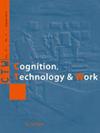Preventive planning against mercury over-exposure among Moroccan dentists using multidimensional statistical methods.
IF 3.4
3区 工程技术
Q2 ENGINEERING, INDUSTRIAL
引用次数: 1
Abstract
BACKGROUND Mercury used in dental amalgams constitutes a significant source of chronic exposure to this heavy metal among dentists. Thus, the safety of dental amalgam remains a controversial issue despite its long history of use. In Morocco, most studies about dental mercury were mainly focused on the environmental risk related to the management of mercury-contaminated waste. OBJECTIVE In order to evaluate the occupational exposure to mercury among liberal dentists practicing in two Moroccan regions, a multidimensional statistical approach was used to analyze the collected data. The main objective was to help establishing a targeted prevention plan aiming to reduce the mercury exposure among Moroccan dentists. METHODS Fifteen variables from 146 dentists were elected for a three-step classification procedure: a multiple correspondence analysis followed by a hierarchical ascendant clustering consolidated by the k-Means algorithm. RESULTS Three homogenous clusters were identified. The most important one includes 57.5% of the population as well as the majority of the risky factors. The characterization of these clusters allows proposing concise guidelines for a targeted preventive plan. CONCLUSIONS A real mercurial risk has been observed in the studied population. However, its impact on health as well as the efficiency of simple preventive recommendations remains to be unveiled.利用多维统计方法制定针对摩洛哥牙医汞过度接触的预防性规划。
背景牙科汞合金中使用的汞是牙医长期接触这种重金属的一个重要来源。因此,尽管牙科汞合金的使用历史悠久,但它的安全性仍然是一个有争议的问题。在摩洛哥,大多数关于牙科汞的研究主要集中于与汞污染废物管理有关的环境风险。目的为评价摩洛哥两个地区自由牙医职业汞暴露状况,采用多维度统计方法对收集到的数据进行分析。主要目标是帮助制定一项有针对性的预防计划,旨在减少摩洛哥牙医的汞接触。方法从146名牙医中选出15个变量进行三步分类:多重对应分析,然后通过k-Means算法进行分层上升聚类。结果鉴定出3个同质聚类。最重要的一个包括57.5%的人口,以及大多数的危险因素。这些群集的特征可以为有针对性的预防计划提出简明的指导方针。结论在研究人群中存在真实的汞风险。然而,它对健康的影响以及简单预防性建议的效率仍有待揭示。
本文章由计算机程序翻译,如有差异,请以英文原文为准。
求助全文
约1分钟内获得全文
求助全文
来源期刊

Cognition Technology & Work
ENGINEERING, INDUSTRIAL-
CiteScore
6.90
自引率
7.70%
发文量
26
审稿时长
>12 weeks
期刊介绍:
Cognition, Technology & Work focuses on the practical issues of human interaction with technology within the context of work and, in particular, how human cognition affects, and is affected by, work and working conditions.
The aim is to publish research that normally resides on the borderline between people, technology, and organisations. Including how people use information technology, how experience and expertise develop through work, and how incidents and accidents are due to the interaction between individual, technical and organisational factors.
The target is thus the study of people at work from a cognitive systems engineering and socio-technical systems perspective.
The most relevant working contexts of interest to CTW are those where the impact of modern technologies on people at work is particularly important for the users involved as well as for the effects on the environment and plants. Modern society has come to depend on the safe and efficient functioning of a multitude of technological systems as diverse as industrial production, transportation, communication, supply of energy, information and materials, health and finance.
 求助内容:
求助内容: 应助结果提醒方式:
应助结果提醒方式:


